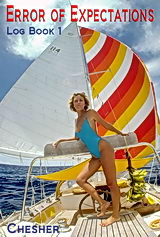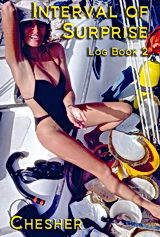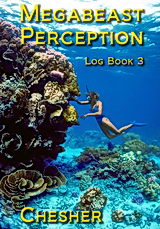PEARLS, PEARLS, PEARLS
One, divided again and again into many focal points of learning.
Visions of giant gold lip pearl oysters dance through my head as Freddy and I pile the diving gear in the Avon and roar out of Belasona harbor into the middle of the China Straits. It is early morning and the tide is rising, the current running north at about 3 knots. Protected on all sides by a multitude of islands, China Straits is a flat calm expanse of deep blue water. The Southeast tip of the main island of Papua New Guinea rears up in green folded splendor to our right. Ahead, the little island of Samarai marks the start of the Louisiade Archipelago. The long labyrinth of islands and reefs reach southeast to Tagula - almost half-way to the Solomon Islands. They offer lots of exploration and adventure for the coming year. We motor slowly into the current, the depth-sounder reporting 110 feet.
"Looks OK here," I drop the anchor until I feel it bump on the bottom. Since Dennis George gets his gold lip from China Straits, there must be some here somewhere. If he has not fished them all out, that is.
Gold lip oysters are the largest pearl oyster in the world. They make great big round pearls worth oodles of great big dollars. Their zoogeographic range is from the Indian Ocean to the Philippines, arching down to the Solomon Islands. In the Torres Straits and in Northwestern Australia, gold lip are big business; both for the pearl shell and for cultivating pearls. They like deep, clear, rapidly moving water. Here in PNG, gold lip have long been used for money. A crescent-carved gold lip hanging around a girl's neck is a sign of great wealth. They are called Kina and today, Kina is also the name for the unit of currency here in PNG. One Kina is worth about 25% more than a U.S. Dollar.
"I'm not too sure I like you're diving alone here," Frederique hands me my regulator. "Neil Stanton said there were some big tiger sharks out here."
"Never fear," I shoulder into my scuba gear with a lot more confidence than I feel. "I'll bring you a present from down there." One last look around and I slide very carefully into the water, trying not to make a splash or bubbles. Big tiger sharks probably do cruise these straits. A silent entry is a prudent entry in my book. It never helps to attract attention to yourself.
I look down the anchor line vanishing into the clear blue and begin the trip to the bottom. I drop down quickly as there will not be much time in this depth. Not to mention the uneasy feeling one gets hanging in mid water with nothing in sight to judge distances. The bottom appears as tiny dark blobs and resolves into a wrinkled sea floor covered with sea whips, soft corals and a rubble-strewn sand.
I do a 360o
lookaround. The bottom waffles off into the gloom about 90 feet in every direction. I grab
the small folding anchor and wind up the anchor line so the anchor and I hang straight
down from the Avon. I turn down current and fly along about 10 feet over the bottom.
To me the water is still, clear, unmoving. The bottom scrolls by. I lower myself down as the bottom drops away into a rock-lined depression.
A black coral tree zips by with a black feather star clinging to its branches. The thick parts of black coral branches are carved and polished for jewlery. Supposed to be a useful protective gem against black magic.
There is a wonderful array of purple-red Stylaster
corals growing on the edges of the rocks little porcelain sea fans only
two inches high. Freddy would love one and the branches would be beautiful
in the action chamber of a Moirascope. Looking ahead, I lower myself
down the line and snatch a tiny sea fan from a rock as it whips by.
Pearls! Pearls! Pearls! I mentally grab myself by the throat and shake myself back to attention (not easy that). One thing at a time. Concentrate on the bottom. Pearl Oysters. Pearl Oysters.
The other edge of the hole appears in the gloom and I clamber quickly up the anchor line and just clear it. I love it. It is just like flying, effortlessly soaring along seeing the bottom glide by with new discoveries just ahead. "Pearls, Pearls, Pearls," I gurgle. "Concentrate!" I sqweeze my lips together, checking for the first effects of nitrogen narcosis. They are slightly numb, but not much. Depth 120 feet. "Pearls, Pearls, Pearls," I stare meaningfully at the sand.
On the other side of the hole the bottom levels out again and my eye catches an even, circular line on the random pattern of sandy gravel. It resolves into a Gold Lip pearl oyster, lying flat on the sand. Another there. I quickly unfold the flukes of the anchor, drop to the bottom, and jam it in a passing hole. The 3 knot current smacks me flat against the bottom. I face carefully into the rushing sea to prevent my mask from being torn off. Near the sea floor there are friction eddies so the current is tolerable. Slowly, hand over hand, pressed against the bottom, I slither up current towards the pearl oyster.
It is a huge specimen, more than a foot in diameter. Gold lips have a golden nacre along the inner edge of the lip and their pearls are either pure white or with a golden tinge. Because the oyster is so big it can support some really big pearls. I saw a necklace around the neck of a superwealthy woman in New York's Waldorf Astoria with gold lip pearls ranging up to almost an inch in diameter. Although they were cultured, that graduated pearl necklace was worth a fortune.
So there are Gold lips here. I dump the oyster in my dive bag and slide over to another. It goes into the bag, too. A dark shadow moves through the edge of my mask and I turn, but can't see anything. Tiger sharks are difficult to see. There could be one just over there. I check my watch. Five minutes bottom time. "I guess I've done enough for now," I say to myself and let go of the bottom. The current washes me back to the anchor and I snatch it out of the rock hole, tie a knot in the line to hold the anchor and the sac about 10 feet off the bottom, and start up the line towards the surface. Ascending, slowly, towards the tiny little inflatible floating on the calm silver sky, I see Freddy's face peering down, her hair a gold aura in the morning sun. I don't bother looking around. I just look up.
She is delighted with the delicate Stylaster - it glistens shocking red in the palm of her hand. I heft and admire the huge gold lip oysters while we motor back to the Moira. "I wonder what they taste like?"
They taste great. Really superb. The adductor muscle is enormous, enough for both of us for lunch. Freddy slices it very thin, bops it a couple of times with our wooden tenderizing mallet, and sautees it about two minutes in garlic butter. She sprinkles on some parsley and serves it with a slice of bush lime.
"HmmmmUm I do believe this is going to be a good project," I slurp.
After lunch we zip over the straits to visit Dennis George's pearl culture facility. It is set in one corner of a small bay just across the strait from Belasona. We tie the Avon up to an old wharf gently falling apart from neglect. Freddy and I balance along the one seemingly fit support beam and are met by a young half European, half Japanese boy. He leads us past two work areas piled high with old oyster shell and up a flower-lined path to a ramshackle house overlooking the China Straits.
Dennis has a reputation for being a crazy old man and when he greets us he does, indeed, have an odd look in his eye. He smiles and is courteous but he's definately edgy. Greek by birth, Australian by naturalization, and resident here in Papua New Guinea, he's been in the pearl business for many years. He got started as a pearl diver in the Thursday Island Pearl Beds. Eventually he married Yuli, a beautiful Japanese woman who looks 100 years younger than he does and sane as can be. She attended a Japanese college for pearl culture and is an expert in seeding oysters .
Over a cup of Japanese tea, Dennis stares directly into my eyes
as he says, "There is a Japanese Law which says pearl culture is strictly a Japanese
industry." I smile, and nod, blowing into the steaming cup. "It is illegal for
any foreigner to have or conduct a pearl culture business without Official Japanese
sanction." I flick my eyebrows quickly up and down, the island way of saying,
"yes." He continues, "The law applies anywhere in the world. If they find
out you are culturing pearls, they move in and stop you anyway they can."
"How can they make you obey a Japanese law in PNG, or in Australia?" I ask in my best, this is a bit hard to believe tone.
"Ha! How indeed?" He leans forward, glaring into my eyes. I sip the tea. His face is flushed. "Well let me tell you what those bastards did to me on Thursday Island!"
So, Dennis tells us how the Japanese ruined his business in Australia. They eventually (so he says) got him in trouble with Australian Immigration. When he went to Sydney to work out the problem - taking Yuli with him - they broke into his house, packed up all his belongings and shipped them lock stock and barrel to Sydney. Then they bought the house he was renting and the boat he was working from. And on and on. He and Yuli came here to PNG to escape the pressure and continue with their pearl culture.
He is positive the Japanese are still after him. Even now, right this minute they are out there, working in the background to destroy his operation here. They are capable of anything. Can hire anyone (he gives me a sly glance which is intended to make me feel guilty just on the off chance I might have sold out to the Japanese at some stage).
All the time he rants about the Japanese and how terrible they are, I keep stealing glances at Yuli who is, after all, Japanese and also very nice to glance at. The whole paranoid scenario falls appart on the simple, obvious fact that Yuli is Japanese, was trained in Japan, and is doing the implants herself. Anyway, the more interesting question is how could such a beautiful Japanese woman be married to such a cantankerous, paranoid, anti-Japanese Greek?
Dennis has what I think of as a Treasure complex. Pearls are his sunken treasure and one day he will become fabulously wealthy from them. The process to produce pearls is the secret treasure map, the pearls are the treasure of unlimited wealth. Every fortune-hunter is seeking to capture the map and the treasure and take it away from him. In fact the treasure map is actually Yuli and I did happen to meet one man who was hunting (unsuccessfully) the secret cross.
Dennis is rattling on about how they only produce half-pearls, which are easier to implant. It strikes me he is oddly insistant about not makeing round pearls at all. Yuli gets out a small sac of blister pearls and Freddy and I admire them. Blister pearls are hemispheres, grown by gluing plastic domes on the interior of the oyster's valve. Between 5 to 8 blister pearls can be cultured on one valve of a big Gold-lip. The material for the "seed" can be made of most anything. The oyster lays down a pearl coating over whatever foreign matter is inside its shell. Since the animal is not harmed, this is a rather safe and easy process providing you have the right domed seeds, glue and tools and are reasonably kind to the oyster.
Blister pearls can have problems. If the pearl coating is too thin or if the base material is not the right kind or if the pearl is not properly filled and backed after being cut from the shell, the pearl might delaminate. Yuli assures us these are perfect and will last forever. This comes across as a bit of a sales pitch so Freddy buys some.
Culturing round pearls is more difficult. First a small hole is cut in the muscle of the foot of the oyster and a spherical seed is inserted along with a tiny bit of the mantle edge. The seed pearl is perfectly round, made from fresh water clams aquacultured in the Southeastern part of the U.S. The bit of mantle tissue contains the pearl secreting cells of the oyster.
Because the oysters have to be surgically cut, semi-sterile conditions must be maintained. Not so easy to do. Even good pearl seeding technicians have a high rate of failure, usually about 20% when a project begins, increasing to about 80% after 6 to 8 years of operation. I think the increase in failure rate with time is related to the build up of disease organisms in the surrounding environment.
Implanted oysters are placed in the sea for six months to two years, depending on how thick the pearl layer is to be. El-cheapos are six month pearls with only a very thin coating of pearl material. At two years the pearl coating is thick enough to last forever with normal wear. But, of course, in two years more oysters can be expected to die. The number of pearls obtained versus the work of collecting, implanting the seed and maintaining the holding facilities decreases with time so the price of the older cultured pearl goes up.
Dennis sends Freddy and I off with his son to look over the facility. As we wander around, I can't help note the huge pile of gold-lip shell. Although it is valuable for making pearl jewelry, they have not bothered to sell it. One big pile of shells shows no evidence of blister pearls. So why were they harvested? I think they were, indeed, used for culturing round pearls. Dennis does not want us to know this. Why not?
Dennis does not want us to know lots of things. The National Fisheries people authorized his pearl project and put up some funding with the idea that Dennis and Yuli would teach local people how to gather and take care of the oysters in village pearl farms. Yuli would go around and seed the oysters and the villagers would look after them until they were ready to harvest.
The government would buy and market the pearls. Dennis sold them a great story to start with and actually set up a couple of village pearl culture stations around here. But something went wrong and nobody but Dennis knows what it was. He backed off. His story was that National Fisheries wants to put their own man as overall manager of the project (a spy for the Japanese). Dennis wants to be the top guy. There is also a dispute about how much Fisheries should pay Dennis as the top guy, and Yuli as top Oyster technician. Every time Dennis goes to Port Moresby to talk with Fisheries he gets pissed off and stomps out for another few years.
The feasibility of the project depends on how many oysters there are. Dennis won't say, Fisheries don't know. The general consensus is there are zillions of gold lip throughout the maze of islands which lead from PNG out towards the Solomons. Pete Wilson, the Director of Fisheries, said Fisheries sent an Accountant down to Tagula to find out how many oysters there were. He came back wild-eyed and raving about the bottom being paved with them for mile after mile. As I understand it, the accountant, after that trip, wanted to be top dog in the project.
Pete Wilson, flew down to Tagula with the Accountant to have a look at the fabled fortune for himself and they couldn't find a single oyster. Pete, a diver since he was a kid, figured the Accountant was exaggerating or imagining things or maybe had nitrogen narcosis. Before sinking more money into the project, he wants me to find out what the population of oysters is really like and where they are.
We eventually get back to Dennis and Yuli. I don't say anything about round pearls or Japanese, I just tell him, honestly, exactly what I'm supposed to be doing. When I finish he glares at me, eyes wide open with a sort of half-knowing smile. What this means is anybody's guess.
Tomorrow, I'm off to Alatau, the capital city of the Milne Bay Province, to get politically oriented.



